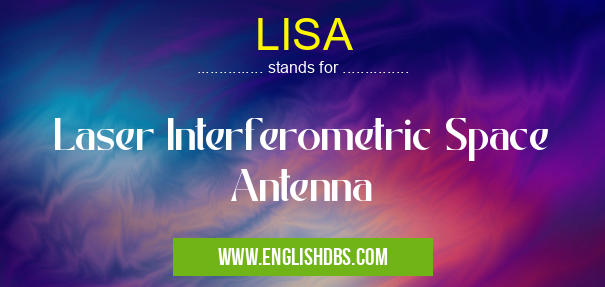What does LISA mean in UNCLASSIFIED
LISA, short for Laser Interferometric Space Antenna, is an upcoming space-based gravitational wave observatory designed to measure infrared light coming from distant astronomical objects. The goal of this mission is to study the properties of gravitational waves, providing insight into the fundamental nature of gravity and the universe. It will use three spacecraft in a triangular formation to detect ripples in the spacetime fabric due to passing gravitational waves from catastrophic events in the far away Universe, such as merging black holes.

LISA meaning in Unclassified in Miscellaneous
LISA mostly used in an acronym Unclassified in Category Miscellaneous that means Laser Interferometric Space Antenna
Shorthand: LISA,
Full Form: Laser Interferometric Space Antenna
For more information of "Laser Interferometric Space Antenna", see the section below.
Essential Questions and Answers on Laser Interferometric Space Antenna in "MISCELLANEOUS»UNFILED"
What is LISA?
Laser Interferometric Space Antenna (LISA) is a space-based gravitational wave detector designed to detect and measure gravitational waves from astrophysical sources.
How does LISA work?
LISA works by combining three spacecrafts which are separated by 2.5 million km in an equilateral triangle formation. Tiny disturbances in the relative distance between these spacecrafts caused by gravitational waves will be recorded with lasers onboard the spacecrafts and communicated to the ground stations.
What can LISA detect?
LISA will mainly target relatively low frequency gravitational waves of 0.1 millihertz to 1 hertz which are emitted by binary stars, the merging of supermassive black holes, stellar remnants like neutron stars and white dwarfs, and other massive stellar objects throughout our universe.
When will LISA become operational?
Currently, LISA is expected to launch in 2034 and become operational sometime after that point.
What types of technology will be used on LISA?
The technology for LISA includes interferometry between multiple spacecrafts using laser links, drag-free attitude control systems using reaction wheels for microthrusters, accurate time synchronization measurements amongst all three spacecrafts, as well as efficient data transmission technology for communication between the ground base station and the space based laser system.
Will it be able to detect individual events or just provide statistics?
As far as single event detection, this capability exists for sources that have sufficient signal power such as compact binary coalescences like mergers of neutron stars or black holes as well as extreme mass ratio inspirals (EMRIs). On the other hand, sources such as Galactic binaries can provide data not only on individual events but also statistical inferences about populations of these events due to their higher number density.
Final Words:
The Laser Interferometer Space Antenna (LISA) is an ambitious project whose aim is detect small changes in the spacetime fabric due to passing gravitational waves from distant sources in space, including massive stellar objects like black holes and other exotic phenomena beyond our solar system's reach. With its capability for precision measurements and unique ability to observe events happening millions of years ago at great distances, LISA has potential applications ranging from fundamental science investigations to detailed observations crucial for understanding cosmology on a grander scale at larger extragalactic scales allowing insights into some of the most mysterious phenomena astronomers can encounter today.
LISA also stands for: |
|
| All stands for LISA |
